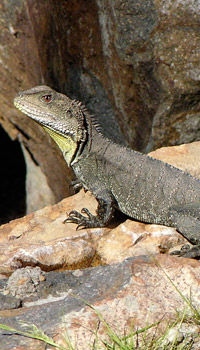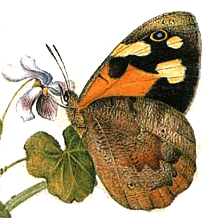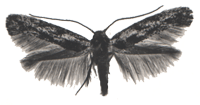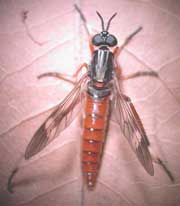External Research Projects in the Gardens (2006 - 2011)
In order of most recent starting dates:
- Water Dragons - Understanding Sex Determination in Reptiles - Professor Arthur Georges
- Energy Performance Simulation of Office Buildings - Aileen Marie Egan
- How Temperature Affects Breeding in Water Dragons - Nadav Pezaro
- Study of Microcaddisflies - Alice Wells
- Can Red Wattle Birds Recognise Cuckoo Eggs in the Their Nests - Dr Naomi Longmore
- How Urban Noise Affects the Song Learning, Development and Evolution of Song in a Native Australian Bird Species - Dominique Potvin
- The Size Distribution within a Selected Plant Population - Ms Rachel Lilley
- The Role of Mutualisms in the Invasion Process for Acacia in Native (Australia) and Non-Native (New Zealand) Species - Elizabeth Wandrag
- Leaf Respiration Plays a Vital Role in Regulating the Earth’s Climate and Ecosystem Functioning - Dr Owen Atkin
- Dragonfly Vision in Low Light Levels - Richard Berry
- Study of Native Bees and Their Associations with Australian Plants - Dr Sujaya Rao
- Scientific methodology and its application to vertebrate species – Melanie Fraser
- Brown Snakes - Donna Douglass
- Why is Mountain Ash a poor resprouter after fire and felling? - Dr Geoff Burrows
- Water-wise wattles - Ms Katy Sommerville & Professor Marilyn Ball
- Using pollen to determine morphological characteristics of genera and species - Andrew Thornhill
- Butterfly mark, release and recapture - Anett Richter
- The relationship between leaf traits and structural nitrogen - Matthew Harrison
- Brown Snakes Survey - Donna Douglas
- Scribbly Gum moths - Max Day
- Eastern Water Dragons - Sean Doody
- Stiletto Fly (Therevidae) - Christine Lambkin
- White-browed Scrub Wren - Robert Magrath
- Superb Fairy-wrens - Andrew Cockburn
Water Dragons - Understanding Sex Determination in Reptiles
Principal Researcher : Professor Arthur Georges
Associate Researchers: Denis O’Meally, Alistair Zealey
Institution: University of Canberra
Start: March 2011
Finish: March 2011
This research will increase our understanding of sex determination in reptiles with Temperature-dependent Sex Determination (TSD), in species that it would be reasonable to regard as particularly vulnerable to global warming.
Permit Number: 2010/11 - 5
Energy Performance Simulation of Office Buildings
Principal Researcher : Aileen Marie Egan
Associate Researchers:
Institution: Australian National University
Start: March 2011
Finish: March 2011
To gather data on temperature across several microclimates in the Gardens. This data will be inputted into a building simulation package to determine the impact of variation of temperature and humidity would have on the energy consumption of a typical office building.
Permit Number: 2010/11 - 4
How Temperature Affects Breeding in Water Dragons
Principal Researcher : Nadav Pezaro
Associate Researchers: Dr. Sean Doody, Prof. Michael B. Thompson
Institution: University Of Sydney, Monash University
Start: November 2010
Finish: January 2011
Research into the effect of fluctuating incubation temperatures on the development of Water Dragon embryos.
To understand how female Water Dragons choose thermally suitable nest sites, the internal body temperature of nesting females will be compared to the temperature of the nests they select (when they select them). The body temperature is a crucial factor in mediating the individual's perception of external temperatures.
Permit Number: 2010/11 - 3
Study of Microcaddisflies
Principal Researcher : Alice Wells
Associate Researchers:
Institution: Australian Biological Resources Study
Start: November 2010
Finish: August 2012
Periodic collection of Microcaddisflies for study
Permit Number: 2010/11-2
Can Red Wattle Birds Recognise Cuckoo Eggs in the Their Nests
[completed November 2010]
Principal Researcher : Dr Naomi Longmore
Associate Researchers: Jenna Crowe-Riddell
Institution: Australian National University
Start: August 2010
Finish: November 2010
A study to test whether red wattle birds can recognise cuckoo eggs in the their nests by placing a plastic egg for a period of 5 days.
Permit Number: 2010/11-1
How Urban Noise Affects the Song Learning, Development and Evolution of Song in a Native Australian Bird Species
[completed November 2009]
Principal Researcher : Dominique Potvin
Associate Researchers:
Institution: University of Melbourne
Start: September 2009
Finish: October 2009
A field study of Silvereye (Zosterops lateralis) vocalizations in urban and rural south-eastern Australia, to compare the possible effects of urban noise on songs (which are learned) and contact calls (which are innate).
Permit Number: 2009/10 - 3
The Size Distribution within a Selected Plant Population
[completed August 2009]
Principal Researcher : Ms Rachel Lilley
Associate Researchers:
Institution: Charles Sturt University
Start: July 2009
Finish: August 2009
The collection of data to determine the distribution of sizes within a selected plant population eg the sizes may be plant heights, tree stem circumferences, leaf lengths, tree canopy widths etc.
Permit Number: 2009/10-2
The Role of Mutualisms in the Invasion Process for Acacia in Native ( Australia) and Non-Native (New Zealand) Species
[completed December 2009]
Principal Researcher : Elizabeth Wandrag
Associate Researchers:
Institution: Lincoln University New Zealand
Start: August 2009
Finish: December 2009
To investigate the role of mutualisms in the invasion process for Acacia in native ( Australia) and non-native ( New Zealand) range. This research will involve 15 species of Acacia within the ANBG. The research will be a monitoring process from August – December 2009. The plants will be tagged – 5 branches per tree (metal tag and flagging tape).
Permit Number: 2009/10-1
Leaf Respiration Plays a Vital Role in Regulating the Earth’s Climate and Ecosystem Functioning
[completed April 2009]
Principal Researcher : Dr Owen Atkin
Associate Researchers: Dr Kristine Crous, Dr Joana Zaragoza-Castells
Institution: Australian National University
Start: February 2009
Finish: April 2009
Leaf respiration plays a vital role in regulating the Earth’s climate and ecosystem functioning. Although it is known that leaf respiration is inhibited by light (by up to 80%), it is currently not possible to predict variations in light inhibition of leaf respiration. This research will use field observations of leaf respiration in darkness and in the light to establish whether there are systematic differences in light inhibition among a wide rate of contrasting plant species growing under common garden conditions at the Australian Botanic Gardens. This work will be combined with additional measurements being made in glasshouse conditions at the ANU. Collectively, the results should make it possible to predict variations in light inhibition of leaf respiration using related leaf traits such as the concentration of nitrogen in sampled leaves.
Permit Number: 2009/01497
Dragonfly Vision in Low Light Levels
[completed April 2009]
Principal Researche : Richard Berry
Associate Researchers: Postdoctoral Research Fellow - Fabian Schmeling
Institution: Australian National University
Start: January 2009
Finish: April 2009
The objective of the research is to determine whether or not dragonfly vision becomes slower and less reliable at low light levels. This will be done by filming dragonflies at various times of the day and comparing video footage of flights occurring during midday to those at sunset. Small tapioca seeds may be fired across the field of view of the cameras to elicit chasing behaviour from dragonflies. A number of dragonflies will be captured by netting so that the species and sex of the dragonfly can be determined. For additional video analysis, some dragonflies may be captured. All Dragonflies will be released from the cage at the end of experiments.
Permit Number : 2009/00037
Study of Native Bees and Their Associations with Australian Plants
[completed February 2009]
Principal Researcher : Dr Sujaya Rao
Institution: CSIRO – Division of Entomology
Start: November 2008
Finish: January 2009
Native bees to be collected by the applicant using nets, hand collecting or traps - 1-5 specimens per species to study native bee diversity at the ANBG and their associations with native plants. All specimens will be stored in the Australian National Insect Collection at CSIRO.
Permit Number: 2008/11731
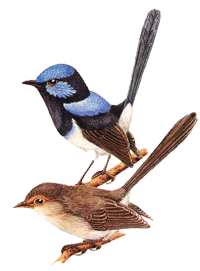 Superb Fairy-wren |
Scientific methodology and its application to vertebrate species
[completed March 2007]
Principal Researcher : Melanie Fraser
Associate Researchers:
Institution: Canberra Institute of Technology
Start: March 2007
Finish: March 2007
The purpose of this research was to undertake a small study of the Superb fairy-wren (Malurus cyaneus) to demonstrate an understanding of the principles of scientific methodology and its application to vertebrate species.
File: DEH 2007/03278
Brown Snakes
[completed December 2007]
Principal Researcher : Donna Douglas
Associate Researchers:
Institution: Charles Sturt University
Start: Aug 2006
Finish: Dec 2007
The purpose of this research is to study the interaction between people and the Eastern brown snake at the ANBG. To do this an ecological survey of the Eastern brown snake population will be conducted to ascertain the size, behaviour and physical characteristics of the population. A survey of visitors, staff and volunteers at the ANBG will also be carried out to determine their knowledge and attitudes towards Eastern brown snakes. The interactions between people and the Eastern brown snake will be recorded to study behaviour on encounter, the location of encounters and the circumstances that lead to snake encounters at the ANBG.
This research will involve trapping the Eastern brown snake that inhabit the ANBG using specially designed funnel traps, cover boards and drift netting. The population is estimated to include 10 – 20 individuals. The snakes length and weight will be measured, with sex determined visually. The snakes will then be microchipped in their abdominal cavity and marked with a non toxic paint to aid in identification. Ethics approval for this project has been granted by the Charles Sturt University Ethics Committee.
It is planned that this study will contribute to the development of educational and interpretive material to improve the management of the Eastern brown snake at the ANBG. In addition, Donna Douglas will provide the ANBG with a draft plan for the safe management of the ANBG’s Eastern brown snake population.
This research is done in accordance with Section 7.3 of the ANBG Management Plan 2002-2008.
Snake Encounter survey form (Word doc) or (PDF) , to fill out if you've seen a snake in the Gardens.
File: DEH 2006/10433
Why is Mountain Ash a poor resprouter after fire and felling?
[completed December 2007]
Principal Researcher: Dr Geoff Burrows
Associate Researchers: Mr David Waters
Institution: Charles Sturt University
Start: May 2006
Finish: December 2007
After fire most tree and shrub species are killed or resprout from below ground level. Most eucalypts differ in that they are able to resprout from their stems and branches (i.e. epicormically) after low to high intensity fires. Dr Geoff Burrows has recently shown that eucalypts have a remarkable epicormic strand structure unlike that found in any other group of trees.
Eucalyptus regnans (Mountain Ash) is an important species from both ecological and forestry perspectives. It is one of the few eastern Australian eucalypts that is killed after forest fire and even more remarkably it is a poor resprouter after being coppiced (i.e. chopped down).
To explain the poor resprouting ability of Mountain Ash various researchers have suggested, without proof, that Mountain Ash has no epicormic buds in its bark. Dr Geoff Burrows is testing this theory by examining the leaf axils and, where possible, epicormic bud strands of mountain ash and other related eucalypt species. This information will be used to determine whether there are substantial differences in structure that may explain differences in resprouting ability.
To perform this research Dr Geoff Burrows and his assistant Dave Waters have collected leaf material and small diameter branches from various Eucalyptus species growing in the ANBG.
File: DEH 2006/06665
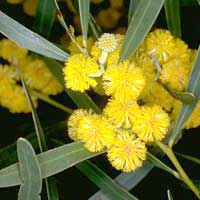 Water-wise wattles
Water-wise wattles
[completed May 2007]
Principal Researchers: Ms Katy Sommerville & Professor Marilyn Ball
Institution: The Australian National University
Start: May 2006
Finish: May 2007
Wattle trees, or Acacias as they are otherwise known, occur just about everywhere in Australia. They are most easily identifiable by their fluffy yellow flowers.
Wattles are water-wise plants. In some places, wattles survive on less than a cup of water every year. Ms Katy Sommerville of the Australian National University aims to determine the role of drought and frost in shaping the evolution and distribution of the wattles in Australia.
Ms Sommerville believes that wattles have a unique plumbing system. Plants move water through a set of pipes that run from their roots to the tips of their leaves. This allows them to draw water from the soil and then move it to wherever it is most needed.
Ms Sommerville and her colleagues are using plant material from the wide range of wattle species found at the Australian National Botanic Gardens to determine if wattles from hot, dry places have a different plumbing system compared to plants from wet areas.
This research is important in helping us understand how plants survive drought. Future work will help us understand how wattles survive the combined effect of drought and frost – a wicked combination for any plant.
File: DEH 2006/06782
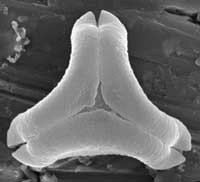 Calothamnus macrocarpus pollen grain |
Using pollen to determine morphological characteristics of genera and species
[completed April 2008]
Principal Researcher: Andrew Thornhill
Associate Researchers:
Institution: The Australian National University
Start: April 2006
Finish: April 2008
The proposed research is part of a PhD project by Andrew Thornhill to use pollen collected from members of the Myrtaceae family to determine the morphological characteristics of genera and species using Scanning Electron and Light Microscopy. This information will be used in plant systematics and palaeobotany.
The work at the ANBG will involve collecting anthers from flowers of Myrtaceae plants, removing the pollen from the anthers in the laboratory and then analysing the pollen characteristics using a Scanning Electron Microscope housed at ANU.
The various pollen characteristics will be used to observe if variation exists amongst Myrtaceae genera and species. The current day pollen will also be compared with fossil pollen, taken from sediment core samples and macro-fossils, to possibly determine correlations between existing and past Myrtaceae species. This information is useful when determining where and when some genera or species existed, including in areas where they may not occur now.
(Picture of a Calothamnus macrocarpus pollen grain.)
File: DEH 2006/05112
Butterfly mark, release and recapture
[completed March 2006]
Principal Researcher: Anett Richter
Associate Researchers: Bernd Gruber, Christina Castellano, Tony Buckmaster, Charly Krebs
Institution: Canberra University
Start: March 2006
Finish: March 2006
To look at the feasibility of mark, release and recapture methods on invertebrates, in particular butterflies, within the gardens. The data set will be used to estimate population size, recapture probability and survival rate.
- Heteronympha merope merope (Common Brown Butterfly)
- Vanessa kershawi (Australian Painted Lady Butterfly)
Butterflies will be captured by net sweeping with individuals captured by hand. While held in one hand the applicants will write numbers on a wing of the butterflies with a permanent marker. Individuals will be released in the same spot where captured. After approximately 2 hours a recapture session will occur to recapture marked butterflies. Once captured in a net, if numbers are readable by looking at individuals, no hand capture will be needed. In total it is expected that there will be 5 recapture sessions.
File: DEH 2006/02393
The relationship between leaf traits and structural nitrogen
[completed May 2006]
Principal Researcher : Matthew Harrison
Associate Researchers: Everard Edwards
Institution: The Australian National University
Start: March 2006
Finish: May 2006
This research was part of an honours project by Matthew Harrison to determine if there is a relationship between specific leaf area ( SLA - area of leaf per unit of leaf dry mass) and leaf structural nitrogen, such as the nitrogen bound into cell walls.
Work at the ANBG enabled the determination of the photosynthetic capacity of leaves of a number of species that differ in SLA, using a portable photosynthetic analyser. Measurements were made on individual leaves (or part of leaf if the leaf was larger than 10 cm long) and these were detached for further study at the ANU.
Subsequent work, to be carried out at ANU, will further define this relationship, which will then be used in leaf models allowing photosynthesis and nitrogen use to be scaled up to canopy and ecosystem levels. This is important for ecosystem modelling and determining ecosystem and plant responses to environmental change, such as growth under elevated CO2.
File: DEH 2006/01334
Brown Snake Survey
[completed April 2007]
Principal Researcher: Donna Douglas
Associate Researchers:
Institution: Charles Sturt University
Start: January 2006
Finish: July 2007
The purpose of this research was to trial several funnel trap designs and coverboards to determine the most effective design for capturing eastern brown snakes. The trial also involved testing capture and marking protocols on one specimen to confirm the suitability of marking, weighing and measuring methods. This trial was the initial part of an overall research project to commence in October 2006 which studied the interaction between people and the eastern brown snake at the ANBG. One of the outcomes of the overall project was to develop a comprehensive plan for the safe management of the ANBG eastern brown snake population.
(Picture: Brown Snakes in ANBG; Picture: male Brown Snakes in ritual conflict)
This research is done in accordance with Section 7.3 of the ANBG Management Plan 2002-2008.
File: DEH 2006/01005
Scribbly Gum moth (Ogmograptis scribula)
[completed July 2006]
Principal Researcher: Max Day
Associate Researchers:
Institution: CSIRO Honorary Researcher
Start: September 2005
Finish: July 2006
Aim: To elucidate the life history of an iconic but little known insect, the Scribbly Gum Moth.
“Scribbles” on the bark of some smooth-barked eucalypts have been commented upon since the days of the earliest settlers in Port Jackson, but it was not until 1935 that it became known that they were caused by the larvae of a moth. This was described by Edward Meyrick in London as Ogmograptis scribula in 1935 from insects sent to him from the then CSIR Division of Economic Entomology in Canberra.
Since that time very little new has been learned, even though the scribbles have become a feature of the Australian bush, in legend and in children’s stories.
We do know that scribbles have been described on about 20 species of Eucalyptus, and that the scribbles differ on different gum tree species. It has been suggested that there are several species of the genus Ogmograptis, but (for species other than O.scribula) neither the adults nor the larvae have ever been described, and no details of the behaviour of any species are known. Where are the eggs laid, what is the duration of the larval and pupal stages,in what tissues in the tree do they fed, how long do the adult moths live, where do the insects overwinter?
In spite of the fact that the insects must be quite abundant, there is no information on these or on a host of other questions.
Scribbles are very abundant on the bark of Eucalyptus rossii, a common species in the Australian National Botanic Gardens, and it is proposed to attempt to work out the life cycle on these, and later hopefully to do the same on other species.
Proposed methods.
In order to accomplish the aims, the first step will be to collect adult moths, mainly by light traps. In addition screens will be used to surround small parts of the trunk during those months of the year when pupae or adult moths are expected to emerge. Screens and light traps will be serviced at regular intervals. Some of the moths will be used for DNA profiling.
To collect larvae, it will be necessary to cut parts of the trunk. This will not be done in the ANBG but on private property in Gunning, NSW, where permission to do so has already been granted.
File: DEH 2005/09880
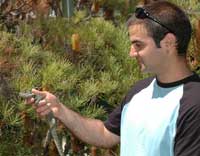 Nadav Pezaro with young dragon Eastern Water Dragon head below. |
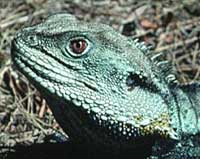 |
Eastern Water Dragons
[completed March 2009]
Principal Researcher: Dr Sean Doody
Associate Researchers: Nadav Pezaro
Institution: University of Canberra
Start: 2003
Finish: Decrmber 2008
A project undertaken throughout 2003-05 set out to determine by what mechanisms do water dragons adjust their offspring sex ratios during range expansion and climate change. Results (including those from ANBG) showed that the pivotal temperature (the incubation temperature that divides the offspring sexes) is not adjusted to produce viable sex ratios throughout various climates, but rather lizards adjusted sex ratios by nesting in areas with different canopy openness indices.
This study will look at the other way that water dragons might adjust sex ratios - sex allocation. The researchers will explore the exciting idea that mothers that mate with high-quality males may produce more sons by nesting in particular areas (in this species egg temperatures determine sex of hatchlings). All individuals in the population will be captured to take DNA samples (very small tip of the tail). By comparing these samples to that of the hatchlings from all the nests located, the researchers will determine relatedness of each clutch, and thus, reveal which males achieved the highest mating success. Then it will be determined if the mothers that mated with the highest-quality males (as determined by the number of offspring produced) produce more sons than mothers that mated with lower-quality males. Sex allocation is known to occur in a few mammals and insects, but not reported for any reptile. Discovering sex allocation in water dragons at ANBG would have a major impact on the study of how animals populations deal with climate change
File: DEH 2005/09913
Stiletto Fly (Therevidae) research
[completed August 2006]
Principal Researcher: Christine Lambkin
Associate Researchers:
Institution: CSIRO Entomology
Start: December 2003
Finish: December 2006
The aim of this project was to conduct fieldwork that provided specimens for taxonomic research on the Australian insect fauna. Specimens are the basic building blocks of taxonomy. Flies including Therevids were collected by hand netting. Specimens were mounted, labelled, identified, curated and stored in the Australian National Insect Collection at the CSIRO Black Mountain Laboratories, Canberra. Therevid specimen information was be entered into an electronic database, accessible through the internet, and used in the preparation of taxonomic revisions of the Australian fauna.
Many stiletto flies (Insecta: Diptera: Therevidae) are found in the Canberra region, and nearby areas such as Tallaganda National Park and Tinderries Nature Reserve. In the gardens in summer and spring the one centimetre long Ectinorhynchus phyciformis may be seen flying around myrtaceous flowers and up to 20 males are often observed swarming in tight groups in protected, sunlit positions about 2 m from the ground. The aim of this project was to conduct fieldwork that provided specimens for taxonomic research of the Australian insect fauna.
Detailed information on Australian therevids including an interactive web-based key to the genera can be found at this web site. Many of the images on the website were photographed locally, including Ectinorhynchus variablis, Belonalys obscura, Acraspisoides helviarta, and Parapsilocephala.
File: DEH 2003/11594
White-browed Scrub Wren (Sericornis frontalis)
Principal Researcher: Robert Magrath
Associate Researchers: Janet Gardner, Ben Pitcher, Dean Ansell, Dirk Platzen, Adam Leavesley, Ashley Leedman, Golo Maurer, Naomi Langmore
Institution: Australian National University
Start: July 2002
Finish: Ongoing
This study focuses on social behaviour and acoustic communication. (1) White-browed scrubwrens are “cooperative breeders” - species in which more than a single pair of adults care for offspring - and have a variable genetic mating system. We ask why individuals cooperate, who are the generic parents, and what consequence does cooperation have for reproductive success? We have examined post-fledging care of young, and found that adults often “specialize” on caring for a subset of the brood. (2) Scrubwrens are very vocal birds, with a large repertoire of vocalizations. We have studied the use of song and calls during territorial interactions, parent-offspring communication, and alarm calls. We are currently interested in the types and meaning of alarms calls, and the calls used when communicating with young.
Methods. Adults and young in the ANBG are banded with ABBBS and colour-bands, and molecular methods have been used to assign paternity. Free-flying birds are mist netted, while nestlings are banded when 9 or 10 days old. We follow reproductive success, and carry out observations on the behaviour of the birds. Vocalizations are recorded, and subsequently used for analysis and for experiments in which vocalizations are broadcast to birds to test their function.
File: DEH 2002/04422
Superb Fairy-wrens (Malurus cyaneus)
Principal Researcher: Andrew Cockburn
Associate Researchers: Michael Double, Helen Osmond
Institution: Australian National University
Start: November 2001
Finish: Ongoing
Superb fairy-wrens have an extremely complex social system. Groups of males live on a territory with a single female who they help to rear offspring. Despite access to males that provide care, females mate with males from outside this social group. Females prefer the males that moult earliest into the nuptial blue plumage each year, and these males dominate paternity. Males court the females constantly by flying into their territories and displaying to them with a dance, sometimes augmented by the presentation of a yellow petal or flower. Remarkably, females mate with their preferred male by flying directly to his territory about 20 minutes before dawn, three days before egg-laying. Andrew Cockburn’s group have studied a colour-banded population of about 70 territories of fairy-wrens at the ANBG since 1988 using a combination of field observations, experiments and genetic analysis of parentage, and this is arguably the most intensive study ever undertaken of a wild animal. The group is currently addressing a range of problems that include:
a) The benefits of female choice. Because males that sire offspring often provide no care this system is well suited to measure the benefits of female choice and the cues females use to choose among potential sires.
b) The signals used in courtship. Males display with brilliant plumage, a courtship dance, the use of flowers, and song during the dawn chorus. We are examining how these cues are integrated and enable the female to find the male in the dark. [call]
c) Conflicts in cooperative societies. Living in cooperative groups appears to benefit females but creates competition among males. We are examining how those conflicts are resolved.
d) Long-term influences on reproductive success. During almost 20 years of study we have been able to monitor the effects of climatic change on reproductive performance and survivorship of the birds.
File: DEH 2001/09648
![Director of National Parks [logo]](../../../images/dnp_90px.gif)





